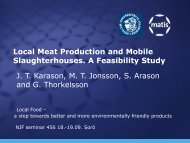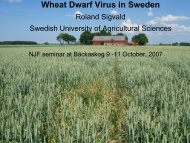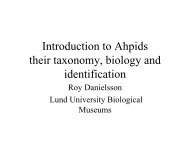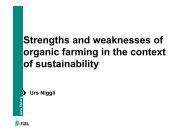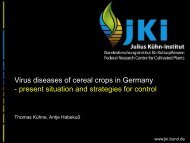Høstmøte for NJF subseksjon for pelsdyr Bergen, Norge 7. - 9 ...
Høstmøte for NJF subseksjon for pelsdyr Bergen, Norge 7. - 9 ...
Høstmøte for NJF subseksjon for pelsdyr Bergen, Norge 7. - 9 ...
Create successful ePaper yourself
Turn your PDF publications into a flip-book with our unique Google optimized e-Paper software.
abstract-296<br />
As regards the increase in weight it seems to be reduced both at constantly low and reduced protein levels,<br />
compared to the normal protein level.<br />
The sensorial judgement of pelts implies that males are more sensitive than females in respect of dietary<br />
changes.<br />
Different planes of energy supply prior to the breeding season<br />
- Effect on blood metabolites in female mink (Mustela vison)<br />
Rikke Fink 1) , Anne-Helene Tauson 1) and Mats Forsberg 2)<br />
1) Department of Animal Science and Animal Health, The Royal Veterinary and Agricultural University,<br />
Bülowsvej 17, DK-1870 Frederiksberg C, Denmark.<br />
2) Department of Clinical Chemistry, Swedish University of Agricultural Sciences,<br />
Box 7038, S-75007 Uppsala, Sweden.<br />
Abstract<br />
Metabolic blood profiles were studied in a total of 30 female mink (Mustela vison) at different planes of<br />
energy supply prior to the breeding season in a control, a flushed and a negative energy balance group.<br />
The experiment, which was divided into six one-week periods, started on<br />
6 February and continued until 20 March. Flushing was per<strong>for</strong>med by restricted feeding in periods 2 and 3<br />
and re-feeding in periods 4 and 5. The animals were weighed weekly and blood sampled at the end of<br />
periods 1, 2 and 4, the two later occasions corresponding to one week after changes in the feed supply of<br />
the flushed group took place. Plasma was analysed <strong>for</strong> total triiodothyronine, total thyroxine, insulin and<br />
insulin-like growth factor-1. Generally, the responses to the experimental treatment clearly reflected the<br />
energy supply of the treatment groups. Within the flushed group differences in animal live weights and<br />
blood metabolites were significant between periods, while these variables remained almost constant in the<br />
control group. Differences between the control and the flushed group were however, non-significant when<br />
considered over the total experimental period, thus confirming that flushing is an acute response, inducing<br />
a rapid fluctuation in energy status, hormone and metabolite concentrations of the animal despite absence<br />
of major changes in the total nutritional status and body conditions. However, the responses in the group<br />
in negative energy balance were typical chronic modulation of the reproductive axis and associated with<br />
considerable shifts in live weight and body condition, leading the differences between treatment groups to<br />
be significantly.<br />
Utvikling i blårevens evne til å <strong>for</strong>døye næringsstoffer.<br />
Sammenligning av viltfanget fjellrev fra Svalbard med farmrev<br />
Øystein Ahlstrøm 1 , Eva Fuglei 2 og Liv Torunn Mydland 1<br />
1 <strong>Norge</strong>s landbrukshøgskole, Institutt <strong>for</strong> husdyrfag, pb. 5025, 1432 Ås<br />
2 Norsk Polarinstitutt, Storgt. 25a, 9008 Tromsø<br />
Sammendrag<br />
file:///C|/Jobb/<strong>NJF</strong>/<strong>NJF</strong>zip_gamla_webben/NJ_Abstracts/abstract-296.htm (16 av 23)2007-01-21 11:52:47



